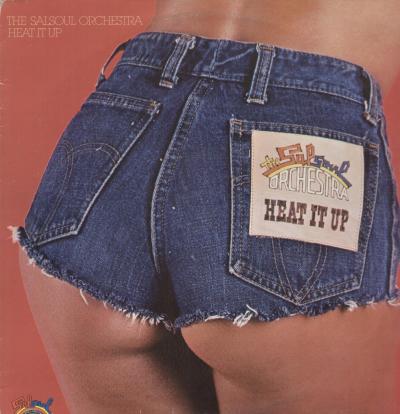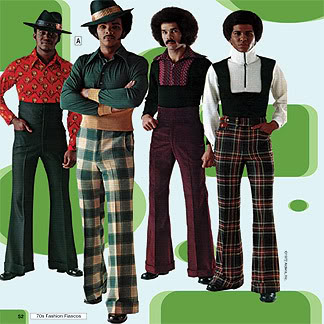
.
Ohh lawd have mercy!
.
I remember the 70s all too well, mostly because I was still rocking bellbottoms in the 80s (my parents had no shame, giving me six-year-old hand-me-downs to wear with my lil Shari Bellafonte-afro-on-a-white-girl hair). It might have been a good look—ten years earlier. But thinking of it now, maybe my parent’s disregard for style is the thing that got me started on vintage fashion, thrift shops, and returning over and over again to the decade of my birth.
.
I came across Maureen Valdes Marsh’s 70s Fashion Fiascos one evening while doing research for That 70s Show, my tribute to New Yawk in the the decade that launched hip hop, punk, disco, and graffiti to the world. By random chance I knew the publisher, who introduced me to Maureen. Our connection was instantaneous, and since then I have enjoyed her brilliance, wit, and aesthetic sensibility. She wrote this essay on 70s fashion for me, and for the first time I am publishing it in full, along with a selection of images from her book, as well some album covers that illustrate her point.
.
70s Fashion Fiascos
By Maureen Valdes Marsh
.
Like a slow turning storm, it spread further and further out from the hub of urbanity until slowly—carefully—it rolled under the crack of suburbia’s front door. Like smoke, like mist, it couldn’t help but leave its fingerprints on everything it touched. “I am here,” fashion whispered. “I am here.”
.
In between the free love of Woodstock ‘69 and the 1980 death of John Lennon lay a decade that would come to be remembered not only by its historical events—the shootings at Kent State, the end of the Vietnam War, the resignation of a president—but also for its pop culture.
.
1970s pop culture wasn’t simply about the excesses of Studio 54 or the squeaky-clean images emanating from the Donny and Marie TV show. The true pop culture of America lay in the day-to-day world of suburbia. As suburbanites, we showed our tender, compassionate side by how we tended and pampered our Pet Rocks. We showed our tolerant side by the patience we exhibited while waiting in endless gas lines. We showed our exuberant nature by the fervor with which we Bumped and Hustled on the disco floor. But perhaps the biggest and most lasting slice of 70s pop culture was in the clothes we wore.
.
.
Free from the constraints of the 1950s and peppered with the new found spirit of the 1960s, fashion in the 1970s took on a life all its own. Flamboyancy was no longer reserved for the young, rich, or famous. Flamboyant urbanity took a short ride over to suburbia’s neighborhood where it was welcomed with open arms.
.
When you look at the lack of choices women faced in the early 1970s, it’s no wonder they became angry enough to burn their bras in protest. It seems in hindsight, however, that they were burning the wrong garment. Even though bra burning was a symbolic act of women’s liberation, was it really the brassiere that was stifling women in the fashion sense? Or was it the overwhelming, in-your-face choices the fashion industry was rapidly throwing at them that made women strike the first match? There was the mini skirt, the midi skirt, and the maxi skirt. Comical circus-tent palazzo pants, sideshow pantsuits, and who can forget clunky, funky, and chunky—more commonly referred to as platform shoes.
.
.
After years of being regulated to the same look, the same uniform Donna Reed-style apparel, the same rules of acceptable/unacceptable dress norms, women were now being overwhelmed by the choices laid out for them. It’s something that we can’t comprehend today. We are used to a society where individuality is the norm, freedom of choice the rule. But for a woman entering the 1970s, freedom of fashion choice created a kind of culture shock. It was like being a kid set loose in a candy store: At first you can’t get enough; everything tastes sweet and delicious. But sooner than you’d imagine, your stomach (and your wallet) start to ache until at last you scream, “No more, please!”
.
.
In the meantime, it was no different for the male of the species. They too were under a barrage of rapid fire fashion bullets. The first rounds out of the chamber were, fortunately, blanks such as the uninspiring “Unsuit”— take one men’s suit jacket, remove the sleeves, scoop the front, slap a hip belt around it and voilà!, the Unsuit. The hot and lethal hits came in the form of plaids intense enough to be seen from the Concorde and platform shoes high enough to garner the American Medical Association’s official disapproval. But none left a lasting impression quite as strong as the posthumously awarded ‘king of the ‘70s’—the leisure suit.
.
Once hailed by top designers John Weitz and Calvin Klein as a garment with staying power, the leisure suit was ostracized from the kingdom of en vogue before the 1970s ever came to an end. Just as it had swiftly risen to the top of fashion, it fell into the leagues of comic relief twice as fast. Today we laugh at the cheesy styles, feminine colors, and garish plaids. But what we seem to have forgotten is that the leisure suit did more than just provide us with years of laughs. The leisure suit helped men open themselves up to new ideas in clothing. It allowed them to experiment outside of the style box they’d been locked in for too many years. If the 1970s had passed without the leisure suit, “business casual” for men might never have developed as soon as it did. The leisure suit may have been a fashion catastrophe, but it laid the groundwork for men to strut their fashion stuff for decades to come.
.
.
As the decade came to a close, the fashions we now so closely associate with the era began to lose their staying power. Polyester garments were cast aside for a return to natural fibers. Women set aside their Day-Glo jumpsuits in exchange for tailored suits. Men replaced their loud, garish, wild-print shirts with muted earth tones and subtle patterns. Sky-high platform shoes were brought back down to earth in the form of comfortable flats. And all those millions of polyester leisure suits? Well, they were shuttled off to the Salvation Army, to await a time when, thirty years later, a new generation would rediscover disco, funk, and That 70s Show.
.






